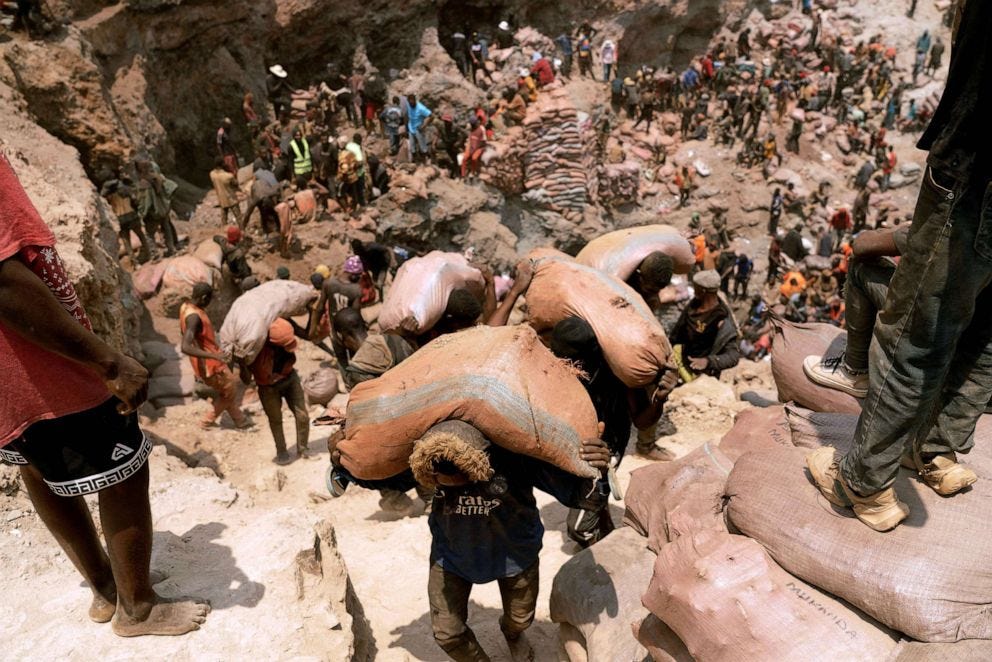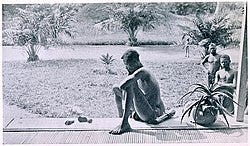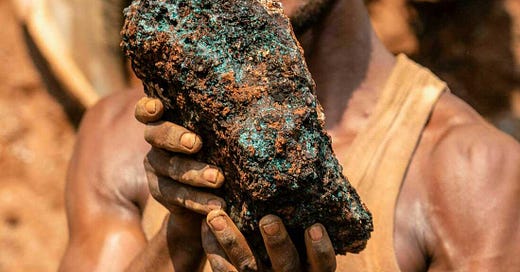History of the Democratic Republic of Congo (Part I)
From Slavery to King Leopold's rule to Colonial Rule to pre-independence....

“The United States has only very poor ores of uranium in moderate quantities. There is some good ore in Canada and the former Czechoslovakia, while the most important source of uranium is Belgian Congo.” — Albert Einstein writing a note to President FDR
Today, we will discuss the low-income, 110M country, Democratic Republic of Congo(DRC or Congo). DRC is THE LARGEST nation in Sub-Saharan Africa, comparable in size as Western Europe. Within its borders, a there’s over 450 different ethnic groups and 70M hectares of untapped arable land. The nation’s economy hinges on the export of commodities (cobalt, tin, copper, tantalium, tungsten, coltan, and etc.), susceptible to volatile global demand. When demand surges, commodity prices rise & budgets soar; when demand dips, commodity prices decrease and revenues plummet. For example, Cobalt a mineral that Congo fuels 70% of global production, was $94K per ton in March 2018, but as of June 2023, the price is $33K per ton — a staggering 66% decrease.

Cobalt is a metal used to make lithium iron rechargeable batteries which is used in every smartphone, tablet, laptop, E-bike, and electric vehicles. In the shift from internal combustion engines to electric vehicles, Congo’s cobalt will be pivotal for the energy transition.

Unfortunately, cobalt/gold/copper excavation has three types of extraction: artisanal mining, small-scale mining, and industrial mining. Artisanal/Small scale mining is estimated to make up 18% to 30% and industrial mining makes up the rest (70% to 82% of mining).
Artisanal miners are subsistence miners who aren’t employed by a mining firm. They endure abuses, health hazards, and fatal accidents just to make meager wages selling ores to middlemen due to limited job opportunities.
Small scale mining involves informal cooperatives to mine instead of individuals. They still lack equipment and resources for state-of-the-art mining health standards.
Industrial mines are mechanized and safe with helmets & ventilation. They are joint ventures between the Congolese government firm, Gécamines, and Chinese, UAE, Canadian and Swiss companies. Foreign firms pay millions in permit fees and royalties to Congo’s government. An example is the Tenke Fungurume mine, it is 80% owned by the Chinese firm Molybdenum and 20% owned by the Congolese government.
Despite legal restrictions, there’s substantial cross pollination of industrial mining companies using artisanal miners.

DRC’s main trading & investing partner is China. Sicomines (32% Congo owned, 68% China) owns 6.8M tons in mineral reserves and 15 of Congo’s 19 cobalt mines.
Here’s the cobalt supply chain:
After Congolese workers give cobalt to middlemen (usually Chinese or Congolese traders), the middlemen give cobalt to cobalt refiners/processors like the Chinese firms Huayou Cobalt or China Molybdenum, or Japanese firm Sumitomo Metal mining. These firms will smelt, process, and/or refine cobalt. They may turn cobalt into :
1. Cobalt Metals & alloys which is bought by aerospace & aerospace component firms (Airbus, Boeing, Rolls Royce or GE Aviation), medical device manufacturers (Zimmer Biomet or Medtronic), or chemical firms( BASF or Dow Chemical)
2. Cobalt Compounds - cobalt oxide, cobalt sulfate, cobalt chloride, or cobalt hydroxide which is used by ceramic firms (Kronos Worldwide or Ferro Corporation) or battery manufacturers( like South Korean firms like LG Chem or Samsung SDI, or Japanese firms like Panasonic).
3. Battery Precursors — Chinese firms like CATL or Chinese car maker BYD, or South Korean firm SK Innovation use cobalt precursors to make lithium ion battery cells for EVs and energy storage systems.
Electronics firms that make Laptops/Hardware/TVs/Video Game/Phones (i.e. Apple, Samsung, Google, Huawei, Dell, HP, Sony, etc.) and EV firms (i.e. BMW, Nissan, Volkswagen, Ford, GM, and Tesla) will buy electric battery cells from Panasonic/LG/Samsung SDI/CATL or make their own battery from cobalt refiners.
China dominates the EV supply chain from mining in DRC (Huayou Cobalt, China Molybdenum) to material processing (Jinchuan Group Co, Jiangsu Cobalt Nickel Metal Co), to cell component and battery cell manufacturing (CATL, BYD, Gotion High Tech Co., and SVOLT), to electric cars (Chinese Teslas, BYD, NIO, SAIC). See chart below:
Congo Artisanal Miner —> Middleman —>Cobalt processor —> Cobalt Cell Component Maker —> Cobalt Battery Maker —> EV or Electronics firm
The Kongo Kingdoms (1390-1914)
“Each day the traders are kidnapping our people- children of this country, sons of our nobles and vassals, even people of our own family… This corruption and depravity are so widespread that our land is entirely depopulated. My Lord, a monstrous greed pushes our subjects, even Christians, to seize members of their own families, and of ours, to do business by selling them as captives.” - King Afonzo of the Medieval Kongo Kingdom to King Joao III of Portugal about the depravity of the slave trade in 1526

The Kongo Kingdoms had laws, traded with Africans and Arabs in ivory, spices, slaves, rubber, manufactured copperware, cloths, and pottery. However, the arrival of the Portuguese in 1482 expanded the slave trade by making a deal with the Kongo Kings. Portugal couldn’t go into the interior of Africa since they died of malaria, so the main Kongo Kingdom, led initially by KIng Joao I of Congo and later his son King Afonso, conducted villages raids, exchanging captives and resources for Portuguese guns and Portuguese Brazil’s food crops. The model of running sugar plantations in Brazil & Sao Tome with black labor was so profitable for Portugal that other Europeans copied them. King Afonso, realized very quickly that Portugal was abusing their contract, but had little power to stop Portugal from controlling the slave trade. Some Kongo Kings loved the slave trade, some Kings wanted to end the trade, some Kings wanted to control the slave trade, and some Kings gave refuge to runaway slaves. Overtime, the Kongo Kings saw themselves as a militarized Christian Kingdom that used Portuguese weapons to capture, enslave, and sell nearby pagan Africans to Europeans.
The Kongo Kingdoms contributed 5.7M of the 12.5M transatlantic slaves (45%). Eventually when Europe ended the transatlantic slave trade Kongo’s main source of export revenue, the Kongo Kingdom collapsed and fragmented into small states, reliant on illegal banditry, rubber, and ivory for export revenue. Then, the land of the Kongo Kingdoms were carved up by France, Portugal and King Leopold of Belgium in the Berlin Conference. Portugal’s territory became Angola, France’s territory became part of Congo-Brazzaville, and King Leopold’s Belgium became the “Congo Free State”. In addition, Omani Arab-East Swahili African slave raiders from Zanzibar, led by Tippu Tib controlled a slave trade & plantations in Eastern Congo.
Leopold’s Congo (1885-1908) or “Congolese free State”
“Cut off hands - that's idiotic. I'd cut off all the rest of them, but not hands. That's the one thing I need in the Congo.” — King Leopold II, the King of Belgium
King Leopold of Belgium, a new European country that didn’t exist until 1831, took Congo as his personal property in 1885 in the Berlin Conference. The invention of rubber tire in 1888 fueled Congo’s importance for the internal combustion engine boom since Congo Rainforest is fueled with rubber. Initially, King Leopold worked with the Arab-East African Swahili slave trade warlords to force Congolese to work for rubber and ivory. By 1892, eventually Leopold declared war on the Arabs on a “Christian crusade against slavery”, which was a front to control Eastern Congo from the Arab slave traders.)
After defeating the Arab-East African traders, he made a joint venture enterprise with British investors, the Anglo-Belgian Rubber Congo Company. The Congolese suffered absurd production quotas for ivory and rubber Harvests for no pay. If the people didn’t meet the quota, they were whipped, tortured, had villages burnt, or shot. Leopold’s private army, Force Publique, hired African and Swahili-East African Arab mercenaries to purposely chop off their hands, rape women, kill men, starve people, burn villages, and and kidnapped 250+ Africans and put them in human zoos in Belgium. Rivers were abundant of corpses. He slaughtered the Congolese population, by killing half of them. Between 1M to 13M Congolese died (We don’t know the exact Congo population under Leopold’s rule, he burned much of the documents).
Leopold’s rule was so horrid, that the UK, USA, and France decried King Leopold of Belgium for its maltreatment against the black Africans (talk about a pot calling the kettle black). Leopold sold Congo to the Belgian government for $215.5M Francs.

Belgian Congo (1908-1960)
Belgium took over from Leopold, turning Congo into a national colony, with meager improvements but continued harsh labor conditions, limited rights, imposed curfews, and denial of land ownership to Congolese.
Rubber exploitation waned since Belgian Congo rubber production couldn’t match the rubber exported by Dutch Indonesia or British Malaya. So, Belgium focused on infrastructure, mining, and (limited) education. French language and Catholic schools were promoted. Medicine experiments caused deaths and cures.
Congolese access to secondary school came nearly 50 years after colonization. Career options were more relatively restricted. Belgians in enjoyed swimming pools, cinema, plush villas in Stanleyville (modern day Kisangani), while Africans faced segregation.
The world wars forced Congolese into service and uranium from Congo was used on the American atomic bomb on Japan sourced by the Belgian firm Union Minière. Despite limited education to Congolese, an educated “evolue” Congolese class emerged, leading to several independence movements.
#1: Joseph Kasa-Vubu sought an independent Congo favoring his Bakongo tribe-ethnicity.
#2: Moise Tshombe advocated for an independent Congo with an autonomous Katanga with Belgian backing. Belgium planned to turn Katanga into a South Africa style Apartheid State after crushing Congo independence.
#3: Patrice Lumumba led the Congolese National Movement, rejecting gradual independence. He was inspired by the recent independence of Ghana in 1957 by Kwame Nkrumah and wanted to nationalize the Belgian companies, which Belgium feared.
Belgium’s initial plan was to give Congo limited self rule and local elections until 1977-1982. But after deadly riots, national elections & independence happened. Belgium gave in to Patrice’s demands, but had ulterior motives. Belgium would aid and fund the conservative Congolese political parties to ensure that Belgium would still have a grip over the economy.
When the election happened, no one had the majority support of the 1M Congolese (only male) voters, but Patrice had the most votes. Nearly half of Patrice’s vote came from Stanleyville in Northern of Congo. Lumumba had very little support in the capital, Leopoldville and other resource rich regions.
With no candidate securing a majority, a coalition government formed with Lumumba as Prime Minister and Kasa-Vubu as President in Stanleyville. However, the newly established government lacked experience in governance, and few Congolese had held significant positions in civil service, education, or other key roles. Only 20 university graduates, 136 secondary school graduates existed, and the country lacked indigenous doctors, high school teachers, and senior army officers. This is very different from Ghana which had a professional class at independence.
Despite Belgium's limited investment in Congolese education, living standards in Belgian Congo were relatively better compared to other African countries. Your average Congolese made $220 a year. For comparison, your average Indian made $83, Nigerian made $93, Kenyan made $102, Sri Lankan $143, and South Korean made $158 in 1960. The only profession Congolese knew were clerks, traders, miners or mechanics.
Due to Congo’s inexperience in government, the government made a “treaty of friendship with Belgium”. Belgium army personnel & civil servants remained until the Congolese personnel could be trained to take over. (Lumumba hated this, but Kasa-Vubu supported this). Belgium made a new constitution for Lumumba that gave provinces the same powers as the central government, leading to immediate power struggles.
Check out further discussion of the Congo Crisis, the Mobutu Coup, the Congo Wars, the two Kabila’s and Tshisekedi’s rule here →
History of the Democratic Republic of Congo (Part II)
If you want to see Part I on Congo: The Kongo Kingdoms, King Leopold, and Belgian Congo, click here: Patrice Lumumba (1960), Republic of Congo-Leopoldville, The Congo Crisis “Can’t we get rid of the guy?” — President Eisenhower of United States, who was referring to the first Prime Minister of Congo, Patrice Lumumba
Sources:
Kongo, Luba, and Luanda Kingdoms, King Leopold’s Rule, and Belgian Congo:
https://stars.library.ucf.edu/cgi/viewcontent.cgi?article=2641&context=honorstheses1990-2015
Lumumba, Kasavubu, and Mobutu:
https://tile.loc.gov/storage-services/master/frd/frdcstdy/za/zairecountrystud00medi_0/zairecountrystud00medi_0.pdf
Book: “Cobalt Red” by Siddarth Kara, Senior fellow at Harvard School of Public Health
“Why Nations Fail”: The Origins of Power, Prosperity & Poverty, Daron Acemoglu & James A. Robinson








